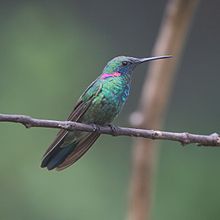White-vented violetear
| White-vented violetear | |
|---|---|

| |

| |
| Scientific classification | |
| Domain: | Eukaryota |
| Kingdom: | Animalia |
| Phylum: | Chordata |
| Class: | Aves |
| Clade: | Strisores |
| Order: | Apodiformes |
| Family: | Trochilidae |
| Genus: | Colibri |
| Species: | C. serrirostris
|
| Binomial name | |
| Colibri serrirostris (Vieillot, 1816)
| |

| |
| Range of C. serrirostris | |
The white-vented violetear (Colibri serrirostris) is a species of hummingbird in the subfamily Polytminae, the mangoes. It is found in Argentina, Bolivia, Brazil, and Paraguay.[3][4]
Taxonomy and systematics
The white-vented violetear is monotypic.[3]

Description
The white-vented violetear is 12 to 13 cm (4.7 to 5.1 in) long and weighs 5.6 to 6.8 g (0.20 to 0.24 oz). The male is mostly shiny green, of a shade lighter than that of other violetears. Towards the rump it is yellow-green with a blue shimmer. The tail is glittering green with a wide steel-blue band near the end. The undertail coverts are pure white. The area behind the eye and covering the ears is violet blue. The female is similar to the male but paler and more grayish. The maxilla of both sexes is sometimes serrated, which provides its specific epithet.[5]
Distribution and habitat
The white-vented violetear is found in a wide swath of southern Brazil, from Mato Grosso east to Goiás, Bahia and Espírito Santo and south to Santa Catarina. Its range extends west into Bolivia, central Paraguay, and northern Argentina as far south as Córdoba Province. It inhabits a variety of semi-open landscapes including scrublands, savanna, grassland, and gardens and parks. In elevation it is most common between 1,000 and 1,500 m (3,300 and 4,900 ft) but its range begins at sea level and extends to 3,600 m (11,800 ft) in the Andes.[5]
Behavior
Movement
The white-vented violetear is mostly sedentary or nearly so; some populations make short migrations. Birds at elevations above treeline in Brazil are believed to move to lower elevations in fall.[5]
Feeding
The white-vented violetear forages for nectar from a wide variety of flowering plants and trees. It also captures insects on the wing. It is very aggressive, calling from a perch and chasing other nectar-feeding birds and even butterflies from flower patches. It tends to begin feeding earlier in the day than other hummingbirds.[5]
Breeding
The white-vented violetear's breeding seasons have not been fully defined, but in parts of Brazil it nests between September and March. The female alone builds the nest, incubates the eggs, and cares for the young. The nest is a cup made of fine fibers and spider silk and decorated with lichens on its outside. It is placed on a branch or in a vertical fork, typically about 1 m (3.3 ft) above the ground. The clutch size is two eggs. The incubation time is 15 to 16 days with fledging 22 to 25 days after hatch.[5]
Vocalization
The white-vented violetear's song is "a constantly repeated 'tsilp, tsilp, zip, tsalp, tsalp'" that may continue for 25 minutes. Its principal call is "a hard 'drüg, drüg, drüg, drüg, drüg'".[5]
Status
The IUCN has assessed the white-vented violetear as being of Least Concern, though its population size and trend are not known.[1] It has a large range, is common in most of it, and occurs in several protected areas.[5]
References
- ^ a b BirdLife International (2016). "White-vented Violet-ear Colibri serrirostris". IUCN Red List of Threatened Species. 2016: e.T22687118A93140848. doi:10.2305/IUCN.UK.2016-3.RLTS.T22687118A93140848.en. Retrieved 14 December 2021.
- ^ "Appendices | CITES". cites.org. Retrieved 2022-01-14.
- ^ a b Gill, F.; Donsker, D.; Rasmussen, P. (July 2021). "IOC World Bird List (v 11.2)". Retrieved July 14, 2021.
- ^ HBW and BirdLife International (2020) Handbook of the Birds of the World and BirdLife International digital checklist of the birds of the world Version 5. Available at: http://datazone.birdlife.org/userfiles/file/Species/Taxonomy/HBW-BirdLife_Checklist_v5_Dec20.zip [.xls zipped 1 MB] retrieved May 27, 2021
- ^ a b c d e f g Altshuler, D.L. and G. M. Kirwan (2020). White-vented Violetear (Colibri serrirostris), version 1.0. In Birds of the World (J. del Hoyo, A. Elliott, J. Sargatal, D. A. Christie, and E. de Juana, Editors). Cornell Lab of Ornithology, Ithaca, NY, USA. https://doi.org/10.2173/bow.wvvear1.01 retrieved December 14, 2021
External links
 Media related to Colibri serrirostris at Wikimedia Commons
Media related to Colibri serrirostris at Wikimedia Commons Data related to Colibri serrirostris at Wikispecies
Data related to Colibri serrirostris at Wikispecies- Footage of birds made in Ecuador, December 2016
- Articles with short description
- Short description is different from Wikidata
- Use American English from December 2021
- All Wikipedia articles written in American English
- IUCN Red List least concern species
- Articles with 'species' microformats
- Commons category link is on Wikidata
- Taxonbars with automatically added original combinations
- Violetears
- Birds of Brazil
- Birds of Bolivia
- Hummingbird species of South America
- Birds described in 1816
- Taxa named by Louis Pierre Vieillot
- Taxonomy articles created by Polbot

